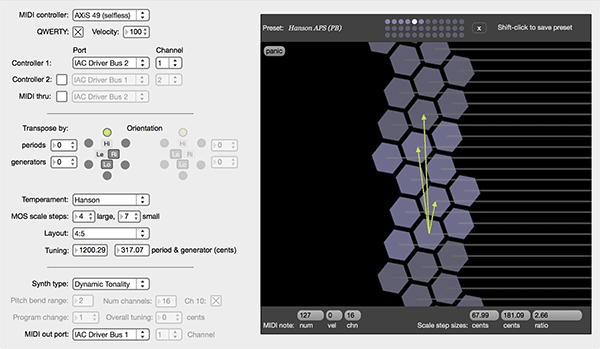Relayer: Isomorphic layouts
Relayer enables musicians who play the AXiS-49, the QWERTY computer keyboard, the Thummer, or any MIDI controller, to play in a wide variety of isomorphic note layouts and tunings using either a Dynamic Tonality synth or a standard multitimbral synth.
When an MOS scale and tuning is chosen (as a preset), Relayer automatically:
- Provides an isomorphic Adjacent Predominant Seconds (APS) note layout in which the scale's most numerous seconds are adjacent and run along rows. The less numerous scale steps are gven by a "carriage return" to the start of the next row above.
- Retunes a multitimbral synth using pitch bend or, if connected to Dynamic Tonality synth like 2032, it will automatically set the tuning to the right value. The tuning is specified by entering a value for the period (pseudo-octave) and generator (pseudo-fifth).
- Allows the note layout, independently for each of two input devices, to be reflected left-right and rotated in 60 degree increments, and transposed by periods and generators.
Each MOS scale is illustrated in a graphic (see above):
- The vertical height of each hexagon corresponds to its approximate pitch. Each octave is colored with alternating shades. This makes it easy to see how to finger the scale.
- The long green arrow (the arrow whose point is the highest) shows the spatial mapping of the period (pseudo-octave).
- The other two arrows show two possible spatial mappings of the generator (pseudo-fifth). The generator arrow whose point is lower corresponds to the mapping when set to "Lo" (in the "Orientation" section); the generator arrow whose point is higher corresponds to the mapping when set to "Hi".
The temperament and layout presets are stored in a text file, which can be customized. In OS X, go to the app, right click and Show Package Contents, go to contents folder, and edit the files called TemperamentPresets.txt or Layouts.txt. In Windows, go into Relayer folder then the support folder, and edit TemperamentPresets.txt or Layouts.txt.
Temperament presets use the following form: The first item on each line is the preset name followed by a comma then comes the period and generator tunings (cents) then the number of large and small steps in the MOS followed by a semicolon. If you want a space in the preset name use "\ ". All lines must end in a semicolon.
Layout presets use the following form: The first item on each line is the preset name followed by a comma then comes the period (if you want a space in the preset name use "\ "); the next four integers define the new layout in terms of the Wicki layout. For example, 5 -4 1 -1 means the period of the new layout is reached by adding 5 Wicki periods and subtracting 4 Wicki generators, and that the generator of the new layout is reached by 1 Wicki period minus 1 Wicki generator. Using transformations that are not unimodular (i.e., a layout defined by a b c d where ad-bc is not equal to +/-1) will result in gaps in the mapping so some notes will no longer play. All lines must end in a semicolon.
In addition to an AXiS-49, it is possible to define custom maps for any MIDI controller. These map from MIDI pitch number and channel number to numbers of periods and generators. This is done by editing the text files "Custom_1" and "Custom_2". Each line in the file starts with the MIDI note number and MIDI channel number inside double quotes, followed by a comma, then the number of periods, then the number of generators, followed by a semicolon. So the line "57 2", -3 5; means MIDI note 57 on channel 2 is mapped to -3 periods and +5 generators. Once a custom map is created, when the Layout menu is set to Wicki, the map works as defined in text file. However, the map can be transformed using the controls found in Relayer (e.g., transposed, rotated, or by choosing any layout other than Wicki)
Multi-timbral software synths we know to work correctly with multichannel pitch bend are the built-in Windows and Mac soundfont synths, SimpleSynth, Alphakanal Automat (set Automat's pitch bend range to full, and Relayer's to 24), the hugely flexible Virsyn Tera, and the excellent piano modeling synth Pianoteq. There are numerous hardware synths that support multichannel pitch bend. H-Pi keep a useful list here. Alternatively, numerous instances of a single software synth can be used, so long as each is set to receive MIDI from a different channel.
Note that tunings can be changed dynamically (while playing), and the timbre automatically matched to the tuning, only with Dynamic Tonality synths.
Downloads
Relayer is a portable standalone application. We uploaded the latest Windows version 1.0.1 on Jan 10, 2015, and the latest macOS version 1.0.4 on Nov 18, 2018.To route MIDI from Relayer to the DT synths, you may need to take the following steps:
In Windows: Install loopMIDI or MIDI Yoke and enable at least 1 MIDI port. When you open Relayer, go to Tracks > Track 1 > MIDI Output Port, and choose a MIDI bus.
In Mac OS X: Go to Applications > Utilities > Audio MIDI Setup. Make sure the MIDI Studio window is showing. Double-click on "IAC Driver" and click the "+" next to "Add and Remove Ports" to add one port, and check the "Device is online" box. When you open Relayer, navigate to Tracks > Track 1 > MIDI Output Port, and choose an IAC bus.
Although Relayer is available free of charge, we would greatly appreciate a small donation to help us continue to provide updates and develop new software.
To send feedback or report a bug, please send an e-mail to andymilne [ a t ] dynamictonality [ d o t ] com.